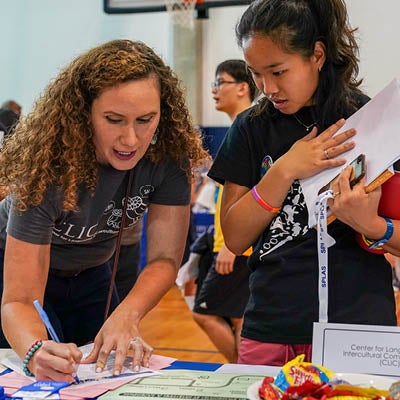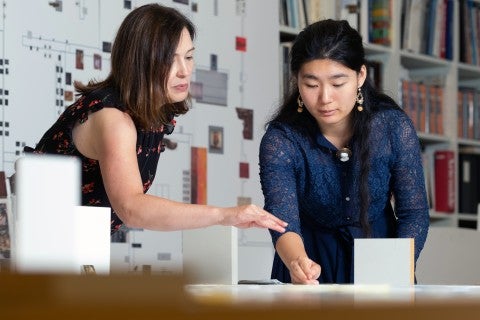
Office of Admission >
The humanities and arts at Rice engage in the discovery, preservation and communication of the past and present in order to more deeply understand contemporary society. Our faculty and students are globally minded and our research and teaching span millennia, reaching from ancient times to the future. We offer our students numerous opportunities for civic engagement and experiential learning. Our internship and practicum programs help students chart pathways to their future professions.
In our popular Big Questions courses — taught by our most innovative scholars and teachers — we invite Rice students to experience how humanistic and artistic inquiry can help them make sense of the world they inhabit and the daily dilemmas our society faces. Big Questions course subjects vary in their focus, but each class shares a common goal of engaging students in a deep dive into those life-changing questions that we ponder well beyond college and that comprise the core of a liberal arts education: “What is the Ethical Thing to Do?”, “What is Religion?”, “What is Hate?”, “What is the Meaning of Death?” Big Questions courses are some of the university’s most sought-after courses, filling up quickly with eager Owls flocking in from diverse majors and academic backgrounds.
It's never been a better time to study the humanities and the arts at Rice.
Funding for Undergraduate Research
The landmark $100 million gift from the Moody Foundation to Rice provides the naming gift for the Moody Center for Student Life as well as new endowments in support of student programs. The School of Humanities is thrilled this gift includes funding for three signature programs, including the Elizabeth Lee Moody Undergraduate Research Fellowship in the Humanities and the Arts, which provides humanities majors with the tools, resources and opportunities to pursue their research interests. Undergraduate fellows receive at least one summer of funding support for a research project or a humanities-related internship.
Fulfilling a Vision for the Liberal Arts
At its founding, Rice was equally dedicated to the fundamental sciences and the liberal arts. But over the years — during the Great Depression and then in response to postwar pressures — our young university increasingly emphasized scientific and technical training. By the late 1960s, Houston arts icons Dominque and John de Menil at last put the arts at Rice on the map. Through their visionary philanthropy and spirited guidance, they brought a team of art historians, an art library, and a photography and film program to Rice.
Fifty years later, thanks to Fayez Sarofim for his lead gift and all who have contributed to our new building for student arts, we are poised to elevate the place of the humanities and the arts on campus — and fulfill Rice’s vision of a liberal arts education. Our stunning 80,000-square-foot Susan and Fayez Sarofim Hall will foster new forms of art practice and redefine the student arts at Rice, one of our most popular majors enrolling some 800 students each year.
Pursuing Humanities Inquiry
Why Humanities and Arts?
Majoring or minoring in any discipline in the humanities and arts at Rice helps to prepare students across a broad range of fields, interests, commitments and professions. Whichever majors or minors you choose in the School of Humanities and Arts, you will embark on a challenging and flexible course of study. Your intellectual engagement will change your life, and you will gain lasting skills to change our world.
Rice Courses in International Locations >
Your experience in the humanities and arts at Rice will both foster and provide:
- Undergraduate Research >
- Creative and Critical Thinking >
- Access to Award-Winning Scholars and Teachers >
- Intercultural, International and Historical Consciousness >
- Challenging and Flexible Learning Opportunities >
- Interdisciplinary Collaboration >
- Internships and Practica >
- The Arts >
- Civically Engaged >
- Study Abroad >
- Lasting Skills >
Why Houston?
Location matters. Houston is a thriving global city and of the most diverse cities in the country with nearly 150 languages spoken here. The Rice campus is adjacent to the Texas Medical Center and near one of the largest museum districts in the country. Students with majors and minors in the humanities make extensive use of both sets of institutions. Rice students engage with many other organizations in Houston as well. Practically every department, center and program in the School of Humanities has its own Houston programs. The city’s rich history and present-day successes and challenges are a valuable part of Rice students’ education.
Majors and Minors
The disciplines of the humanities are the lenses through which our faculty and students examine the human experience. Each discipline was created at some moment in the past, has changed in response to each generation’s questions, and new disciplines are emerging today. They do not stand still, and neither do we. At Rice, our academic departments offer many ways to major and, for graduate students, to pursue a graduate certificate. The School of Humanities also houses several centers that bring together faculty for interdisciplinary research, teaching, publications and other activities, as well as several other interdisciplinary programs. Our Center for Languages and Intercultural Communication offers instruction in languages, both at Rice and abroad. We encourage students to acquire or further develop a second or third language.
Student Life
The School of Humanities and Arts at Rice University is a top-quality liberal arts college rolled into a research university. Its small scale, combined with its research focus, brings advantages to both undergraduates and graduate students.

